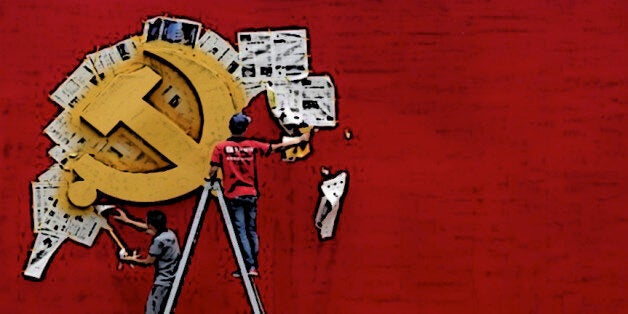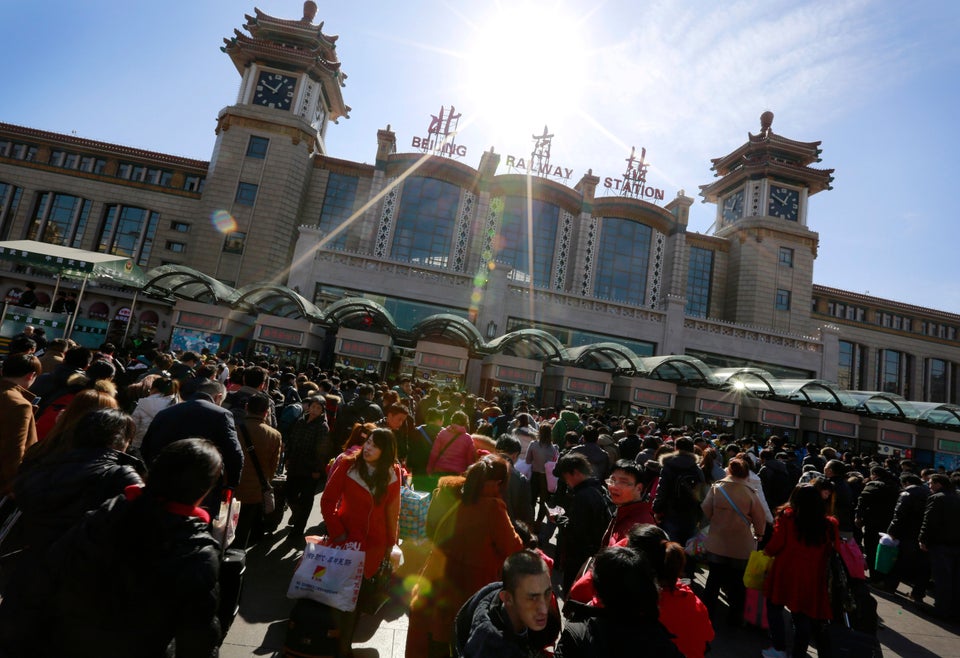
This article is adapted from a speech entitled "Catching up with the Times and the Communist Party of China" at the Second "Understanding China" International Conference held in Beijing in early November.
BEIJING -- To understand where China is headed over the coming years, one must also understand the Communist Party of China, since the CPC leadership is a fundamental feature of socialism with Chinese characteristics.
A prominent major characteristic and advantage of CPC today is that it keeps abreast of the times featuring two overriding themes: peace and development. As Deng Xiaoping exhorted, "We must catch up with the times, and this is the objective of our reforms." Hence, my topic here is "catching up with the times" and the CPC.
Some History
The CPC came into being in 1921, almost a century ago. It aims to complete the building of a moderately prosperous society in all aspects when it celebrates its centenary in 2021 and achieve a modernization of China by 2049, 100 years from 1949, when the People's Republic of China was established. These are what we call our "two centennial goals."
First of all, let me present the following figures in relation to the two centennial goals of the CPC:
- The CPC started with about 50 members in 1921. Today, its membership approaches 88 million.
- Through 28 years of revolution, including 21 years of armed struggle, the CPC founded the People's Republic of China.
- China's GDP ranks second in the world today, an accomplishment achieved through arduous efforts over the past 66 years since the founding of the PRC, especially through the rapid development during the past 37 years of reform and opening up. In another five years, China is expected to realize its goal of "completing the building of a moderately prosperous society in all aspects."
- It will take China another 35 years to achieve an all-around modernization in terms of per capita GDP, scientific and educational sophistication, social governance and ecological sustainability.
- Even if China may be on a par with or surpasses the United States in terms of GDP at that time, it will remain a medium-level developed country given that its per capita GDP will be no more than the world average.
That's why we need to take a two-sided view on the question of "catching up with the times."

A Two-Sided View
The century-old CPC has come a long way since its birth. In barely 100 years, the CPC withstood two fundamental tests and met them with two seminal responses.
In modern times the Western powers, including Japan, plunged feudal China into the abyss and the Chinese nation faced a severe test of life and death. China went through nearly 100 years of wars, from the Opium War of 1840 all the way to the War of Resistance against Japanese Aggression (1931-1945) during which Japan occupied a large part of the Chinese territory for 14 years.
The Communist Party of China came into being amid the surging Chinese revolution. It led the Chinese people in fighting revolutionary wars and after its eventual victory, founded the People's Republic of China, hence paving the way for the establishment of China's socialist system, the reform of the Chinese society and development of productive forces.
Thus, a major test of the times characterized by wars and revolution was turned into a major opportunity for the Chinese people to stand up. That was the first fundamental test faced by the CPC and its first seminal response to the test.
The technological revolution around the world and a new wave of economic globalization in the late 1970s, coupled with the changing international landscape after the Vietnam War and the (Soviet) Afghanistan War put China to another severe test: a different kind of test in a time of peace. Thanks to this new test, China had no choice but to embark on the road of reform and opening up to the outside world. Reform and opening up, or the "second revolution" as we call it, which started in 1978, marks the beginning of an all-around reform and unprecedented development of productive forces that will continue throughout the entire first half of the 21st century.
Thus new tests are turned into new opportunities. A major test of the times characterized by peace and development has been tuned into a major opportunity for the Chinese people to develop rapidly. We call this the second fundamental test faced by the CPC followed by its second seminal response.
In meeting the first test, the CPC embarked on an innovative path of revolution by formulating a strategy of surrounding cities from the countryside, which was different from Russia's October Revolution. In meeting the second test, the CPC blazed a completely new strategic path of building socialism with Chinese characteristics, which is different from the model defined by class struggle and centralized economic planning.
No Smooth Road
The road taken by the CPC over the past 100 years has never been smooth but tortuous and arduous. In general terms, this road can be summed up as comprising two Z-shaped segments.
The first Z-shaped segment -- the period of democratic revolution -- spanned chronologically from 1921 to 1949, and the second segment, from 1949 to 2015, has covered the period of socialist revolution, economic development and reform and opening up after the founding of the PRC.
In the 28 years of the first segment, the initial six years went by rather smoothly, with the KMT and CPC joining hands in carrying out the Northern Expedition (1926-1928) against the northern warlords. In the middle 10 years, the democratic revolution suffered serious setbacks due to the betrayal by KMT and the leftist mistakes made by the CPC. The last 12 years of this period witnessed the War against Japanese Aggression and the War of Liberation before the People's Republic of China was founded.
While we made significant progress in building socialism, 'leftist' ideology began to gain ground and eventually led to the tempestuous Cultural Revolution that lasted 10 years.
The second Z-shaped segment, which is still ongoing, started 66 years ago when the PRC was founded. In the first 7 years of this period, the socialist transformation of private ownership of the means of production went rather successfully. In the middle 22 years, however, while we made significant progress in building socialism, "leftist" ideology began to gain ground and eventually led to the tempestuous Cultural Revolution that lasted 10 years. Afterwards, in the ensuing 37 years, the CPC focused on development of the productive forces, reform and opening up and a market economy. Its course in these years has adhered tothe fundamental system of socialism and development of a modern national governance system, to independence and self-reliance while joining the economic globalization process and to a peaceful rise.
Z-Shaped Path
"Catching up with the times" by meeting challenges and seizing opportunities is a major theme and a key thread that runs through the two Z-shaped segments the CPC has gone through in the past 100 years in responding to the two fundamental tests.
By "catching up with the times," the CPC first saved China and then guided it on the path of development. Even today, if the CPC fails to "catch up with the times" by leading the Chinese people in achieving modernization in an all-round manner under the new historical circumstances, China will not be able to stand proudly amongst the nations in the world and avoid "no longer be[ing] worthy of its place on Earth" -- as Chairman Mao put it at another crucial moment in 1956.
The five development concepts contained in the Recommendations on the 13th Five Year Plan adopted by the 5th Plenary Session of the 18th CPC Central Committee -- innovation, coordination, greening, opening up and inclusiveness -- are a clear manifestation of the CPC's determination to catch up with the times in the next five years leading up to the completion of the building of a moderately prosperous society.
Upon reflection, "catching up with the times" has been a dominant theme throughout the 100-year history of the CPC and has profoundly dictated the sense of mission and aspirations and pursuit of the CPC throughout the primary stage of socialism. At the same time, it also proves that the CPC has not existed out of expediency, still less for selfish gains.
The Party Itself Must Catch Up With the Times
While leading the people in "catching up with the times," the CPC should "catch up with the times" in its own development. It is essential that as the ruling party the CPC improve democracy within the Party, govern the country according to law and tighten Party discipline strictly and according to law (including state laws and the more stringent Party regulations). These have been prominently emphasized and practiced since the 18th CPC National Congress.
'To forge iron, one must make oneself tough,' as General Secretary Xi Jinping has emphasized. Power must be put in the cage of law and regulations.
"To forge iron, one must make oneself tough," as General Secretary Xi Jinping has emphasized. By strictly adhering to Party discipline since the 18th CPC National Congress, and by "putting power in the cage of laws and regulations," the CPC has ushered in a new phase of governance, therefore enhancing its ability to "catch up with the times."
What is most noteworthy is the resolve that the CPC has demonstrated in publicly exposing and eliminating its own undesirable elements.
A Unique Party in World History
The CPC has proven itself in its 100-year journey to be a unique great party in the world history of political parties and the history of international Communist movement for the following four reasons:
First, born and growing up in times of war rather than times of peace, the CPC led the Chinese people in seizing national power and remains in power ever since. It is the largest political party in the world.
Second, the CPC is not a Party driven by the pursuit of selfish interests, nor is it undisciplined or indolent. Rather, it is an advanced political party based on strict internal discipline and the support of the people. It reaffirms that it is not only the vanguard of the working class of China, but also the vanguard of the Chinese people and the nation as a whole.
Third, the CPC is not a hegemonic political party holding the banner of "world revolution." Rather, despite the differences in social systems and ideologies around the world, it endeavors to seek convergence of interests with other countries and promotes China's peaceful rise along with the peaceful rise of a vast number of other developing countries.
Fourth, the CPC is not stuck in its old ways, nor does it cling to ossified dogmas. Rather, it is a political party that is always learning and innovation-oriented in line with the characteristics and realities of the primary stage of socialism. All Party members must learn from and draw on all beneficial results of civilizations of mankind and avoid the dogmatization of Marxism by adjusting it to Chinese realities, remaining open to saying "things our forefathers had never said" (Deng Xiaoping) in light of new conditions. This is true of Mao Zedong Thought as well as Deng Xiaoping Theory upon which the entire theoretical framework of socialism with Chinese characteristics is built. It keeps pace with the times both in theories and in Party lines, absorbs the best and brightest from all quarters of the society, and innovates and transforms its ways of governing the country. These constitute the distinguishing characteristics of the CPC.
The Road Ahead
The road ahead for the CPC is long and arduous, and various challenges along the way remain grave. Under such circumstances, the CPC is destined to "catch up with the times" by making changes in some areas while staying the course in others; by catching up in some aspects and transcending old ways in others.
The CPC will not and must not change its fundamental aim of serving the people, or its ideological principles of liberating the mind and seeking truth from facts, nor its paramount task of building socialism with Chinese characteristics. At the same time, it must continue to "catch up with the times" by constantly making necessary changes or revisions to various concepts, theories, ways of work and systems of governance. These changes are carried out to make sure that our fundamental aim, ideological principles and paramount task will remain unchanged.
In the same vein, continuous reform and innovative development are fundamental requisites for "catching up with the times," which means we must work hard to stand in the forefront of the times, in other words, to transcend the times.
In terms of reform and development, China has elevated the role of the market in resource allocation from being basic to being decisive and will further balance the relationship between the market and the government. The country aims to transform the mode of economic development from being investment-driven to innovation-driven, to integrate the rural and urban areas by dismantling the rural-urban dual structure, among other things. These are some of the major changes being made. In particular, the "One Belt, One Road" initiative and the Asian Infrastructure Investment Bank proposal, both made by the Chinese government, constitute an upgraded version of the national policy of opening up to the outside world.
Regarding innovation of the national governance system, the CPC seeks to modernize this system by adjusting the relationship between the Party and the government, expanding democracy both inside and outside the Party, and improving the People's Congress system and the system of socialist consultative democracy.
Proponents of a multiparty political system argue that only multiparty democracy is real democracy and ensures modernization. The Chinese experience, however, has proven otherwise.
Proponents of a multiparty political system argue that only multiparty democracy is real democracy and ensures modernization. The Chinese experience, however, has proven otherwise. As we clearly remember, more than 300 "political parties" participated in the 1913 Republic of China elections, leading to the election of Yuan Shikai as China's first president. Later Yuan Shikai restored the monarchy and proclaimed himself emperor, and his reign lasted no more than 83 days.
The multiparty political game, now being played with fervor and with serious consequences in certain parts of the world, was played a century ago in China, albeit for a brief period of time. Modern China is following a completely different road to democracy. The CPC is the ruling party while the eight other non-communist democratic parties are "participating" parties. Also, the electoral system and political consultative system are continuously being improved and are becoming increasingly vibrant as democracy and rule of law are unified. This is what we call a political system with distinctive Chinese characteristics, and it is there for everyone to see or study.
In the final analysis, at its essence, "catching up with the times" means that the CPC goes its own way and keeps in the forefront of the times through continuous reform, innovation while learning from others through the "latecomer advantage."
China Needs to Understand the World
Last but not least, I would like to highlight that while the world needs to understand China, China also needs to understand the world.
Whether to understand China or to understand the world, we all need to take a two-sided view. For China to understand the world we not only need to draw upon useful results from other societies but also to learn from their lessons and mistakes. In particular we must avoid the turmoil and chaos that have caused unspeakable suffering to the people in some parts of the world. While peace and development are still the themes of our times, the world is far from being peaceful, and we must still give top priority to sovereignty and national security.
In China we have accumulated successful experience over the past 30 years of reform and opening up. While being optimistic about our prospects we mustn't underestimate the difficulties ahead. For instance, we should constantly bear in mind that China's per capita GDP stands at around 2/3 of the world average or 1/7 of that of the United States, ranking below the 80th worldwide. In terms of social progress and transformation, as gauged by scientific and technological level, quality of the citizenry, democracy and the legal system, and environmental protection, China still has a long way to go.
China still has a long way to go.
This requires that the CPC and the entire Chinese nation redouble their efforts as they forge ahead and, at the same time, be more sober-minded and modest.
In the meantime, we expect the international community to understand and respect the efforts and aspirations of the Chinese people.
We hope that our international friends will see China from this perspective and, on this basis, proceed to better understand the CPC and the Chinese people. In the meantime, the CPC and the Chinese people will also seek to better understand the world and do a better job in "catching up with the times." Both China and the world will be better off if we do so!
Earlier on WorldPost:

